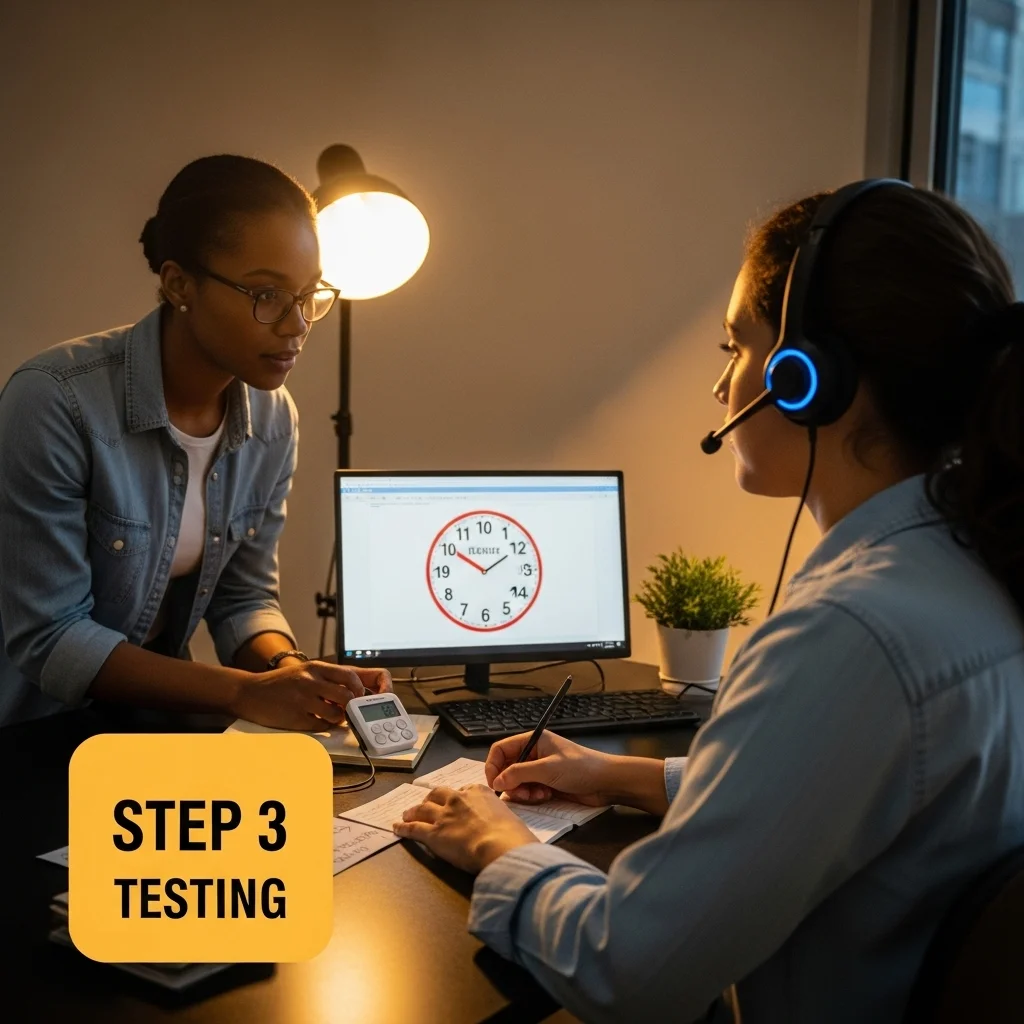Why prototype right now
Because you learn faster today than tomorrow, and choose the right direction while the risks are still low. A prototype makes choices visible, discussable and testable — with real users, realistic flows and clear next steps.
Automate
Repetitive work belongs to the machine, not your team. Thanks to AI-driven components, design systems and prompt-guided flows, we generate consistent screens and states. Less tinkering, more learning. And all within hours, not weeks, so feedback cycles stay naturally short.
Validate
Nothing is as expensive as assumptions that fail too late. With a clickable, realistic prototype you test navigation, copy and logic. You see where people get stuck, what feels intuitive, and which micro-interactions remove friction. The result: decisions based on evidence, not gut feeling.
Engage
Stakeholders and users find it easier to contribute when they can experience the product — everyone literally sees the same things. Discussions become concrete: flow A or B, variant X or Y. That speeds up governance, prevents noise and aligns teams, compliance included.
Iterate
Prototype development is not a one-off sprint. It is a rhythm: learn quickly, adjust sharply, test again. Teams that embrace this rhythm demonstrably have less rework later and move towards MVP with greater confidence.

The essence of prototype development
The essence of working with prototypes is simple: surface uncertainties when they are still cheap. You combine vision with evidence, design with data, and make trade-offs visible. This not only creates buy-in but also a clear roadmap that aligns with reality.
What you really want to achieve
Clear decisions based on behaviour, not assumptions
A clickable story that investors and teams understand
A practical bridge to realisation, without lock-in
Evidence over assumptions
The best feedback comes from behaviour: clicking, swiping, scrolling. That is why we test realistic journeys, not loose screens. Subtle copy, micro-animations, empty states — it all adds up.
Where teams often get stuck
Too much scope in one go. Too little real data. Slick demos that hide edge cases. In practice “too perfect” is misleading — better an honest prototype that shows friction than a shiny tale that hides errors.
The pragmatic route forward
We start small, make scenarios concrete and reveal choices with variants. Next we test purposefully, measure friction points and translate insights into a feasible first release.
Small workshop as jump-starter
Prototype live within one day to a week
AI-supported flows for speed and consistency
Testing with real tasks, not vague questions
Clear next steps towards MVP and TRL level
How do you navigate this new prototype reality?.
Theory is fascinating, but the value lies in translating it into practice. Here is a step-by-step approach to implement the insights without choking on complexity.

Step 1 — kick-off workshop.
We begin with a compact, energetic session in which we clarify goals, select primary flows and make critical assumptions explicit. Think: who is the user, which tasks truly matter, where are the biggest risks. We choose a maximum of two scenarios for focus (too much scope is the enemy of speed). Often we sketch wireframes live, draw variants and make firm choices about copy, data and edge cases. The result is a prototype that is not “pretty” but primarily “fit for learning”.

Step 2 — prototype sprint.
We build a clickable, realistic prototype including states, error messages and micro-interactions. AI accelerates here: generating component variants, copy-as-a-service, synthetic yet relevant data samples. We employ design systems to guarantee consistency while leaving room to experiment. And — importantly — we also show non-ideal paths (what happens with empty lists, time-outs, incorrect input?). Those paths often deliver the real gold.

Step 3 — test and learn.
No perfunctory round of “what do you think?”, but tangible tasks: “Register X, change Y, complete Z.” We observe, time and note behaviour patterns. Then we cluster findings by impact and effort. Sub-steps: (a) define success criteria per task; (b) involve 5-8 testers; (c) analyse together; (d) decide what you fix now and what can wait.

Step 4 — technical feasibility and TRL fit.
We align the prototype outcome with your technical strategy. Which integrations are critical? What does this mean for security and privacy-by-design? And where are you on the TRL scale? In TRL 4-6 you validate prototypes step by step: from lab scale, to relevant environment, to demonstration in a test setting.

Step 5 — towards MVP (without lock-in).
We translate insights into a concise MVP roadmap: which features are essential, which can wait, which are dropped. We capture design decisions in components and guidelines so further development is not a reset. And because the prototype is not a code base, you can later choose the most suitable tech stack — providing peace of mind.


Shall we make your idea tangible?
Book a short workshop and experience how a clickable prototype, delivered within one day to a week, sharpens your course. No pushy sales — just a joint look at where the most value lies, and making that visible fast with the quickest AI development methods. If it clicks, we carry on building. If not, you still gain clarity.

Prototyping is daring to make choices
Those who try to prove everything at once often prove nothing. Prototype development is about naming uncertainties and eliminating them systematically — sometimes with a rough flow, sometimes with pixel-perfect screens. It is like chess: not every piece must move at once, but every move must be deliberate.
Why you should experience first and build later
Experience reveals friction that documents hide
Real interaction sharpens copy and order
Buy-in grows faster around something tangible than around a memo
Proof of concept versus prototype
A proof of concept (PoC) demonstrates technical feasibility: can it be done, does the technology work, is the integration possible. A prototype simulates the user experience: this is how it feels, how you navigate, these are the states. Both are valuable but answer different questions. In TRL terms a PoC is usually around TRL 3, while prototypes move towards TRL 4-6 — first in lab scale, then in relevant and test environments.
The power of variants
What happens if you shorten the call to action? What if you place filter options below the search bar rather than above it? By prototyping and testing two variants, you see the effect without endless debate.
Realistic data, realistic reactions
A prototype with domain-specific language and believable datasets (synthetic if necessary) triggers better feedback.

How to build a prototype that works
The pitfall is well-known: too slick, too polished, not real enough. A working prototype feels authentic, edge cases included.
Practical guidelines for immediate results
Limit scope without being naïve
Choose two primary tasks and work them out in depth, including entry and exit.
Make interaction tangible
Clickable means more than linking screens; add micro-interactions.
Let AI boost speed and quality
Generate component variants to accelerate design choices
Use AI for first drafts of micro-copy
Synthetic test data that mimics patterns
Rapid flow sketches from user stories
Test like a researcher, not a presenter
Observe, note, time. Behaviour beats opinions.

Looking ahead: prototypes are getting smarter
The line between design and build is blurring. AI, design systems and TRL-driven development paths mean prototypes are not only created faster but also predict more accurately how the final solution will perform.
Generative flows based on goals
From goal to automatically suggested screen flows.
Synthetic everything
Synthetic data and scenarios let you safely simulate complex behaviour.
Bridge to implementation without lock-in
Prototypes remain code-free yet generate artefacts that support your build team.
What is the difference between a prototype and an MVP? 🤔
A prototype is designed for learning and decision-making — fast, inexpensive and without code. You simulate the experience: navigation, states, copy. An MVP is the first working product that delivers real value in production. Prototyping helps you decide sharply what belongs in the MVP and what does not.
How quickly can we have a professional prototype? ⏱️
We start with a brief workshop and, within one day to a week, deliver a professional prototype.
Do we need a fully-fledged design already? 🧩
No. In fact, it is often better still to have outstanding questions.
Do you also test with real users? 🧪
Yes, but “real” means tasks that match your domain, with realistic (synthetic if necessary) data.
What if stakeholders cannot agree? 🧭
By letting them experience variants, you shift the debate from opinions to behaviour.
Does this fit our governance and security requirements? 🔐
Absolutely. Prototypes run on secure tooling and use anonymised data.
How does this relate to TRL levels? 🧩
Proof of concept and prototypes are key in TRL 3-6.
Does prototyping work for complex B2B processes? 🏗️
Precisely there. Complexity often lies in exceptions.
Which tools do you use? 🛠️
We choose tooling that suits the context.
What happens after the prototype? 🚀
We translate insights into a clear MVP roadmap.










.webp)
